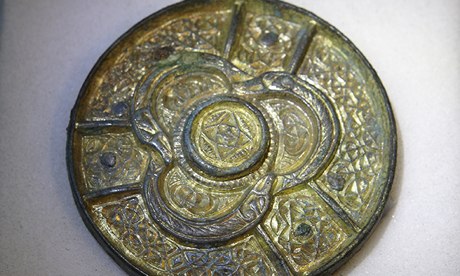http://www.theguardian.com/culture/2014/jan/05/vikings-treasure-excavation-british-museum
The Celtic brooch looted by the Vikings and discovered in the museum's collection. Photograph: Andy Hall for the Observer
A Celtic treasure looted by the Vikings more than 1,000 years ago has been discovered in the British Museum's storerooms. An ornate, gilded disc brooch dating from the eighth or ninth century was found by chance and is being described as a "staggering find". No-one knew of its existence until now.
It had been concealed in a lump of organic material excavated from a Viking burial site at Lilleberge in Norway by a British archaeologist in the 1880s and acquired by the British Museum in 1891.
Curator Barry Ager, a Vikings specialist, was poring over artefacts before a visit from a Norwegian researching the Viking site when his eye was caught by some metal sticking out of the side of the organic lump.
Intrigued, he asked the conservation department to X-ray it. "At that stage, I really didn't know what was inside," he said. "It was a staggering find."
He added: "It turned out, quite remarkably, to be this Celtic disc… It's extremely exciting… It's a very rare example of its sort within the collection… shows contact between the British Isles and Norway in the Viking period … objects seized as loot in this country and taken back."
He believes that it was originally made in Ireland or Scotland, that it came from a shrine or a reliquary, and that the Vikings converted it into a brooch by attaching rivet holes and a pin.
The brooch, almost 6cm in diameter, had been buried in the grave of a high-status Viking woman. Substantial remains of the gilding still survive on the top surface and its elaborate design includes three dolphin-like creatures and interlaced patterns.
"The …patterns, the quatrefoil of the central roundel and the form of the 'dolphins' heads have clear parallels in Celtic metalwork and manuscripts of the 8th to early 9th centuries, such as the Tara Brooch and the Book of Mac Regol," Ager said.
He described the craftsmanship as "very fine" and said that the Vikings valued "eye-catching" objects: "The Vikings themselves were very skilled metalworkers, so I'm sure that's something that would appeal to a Viking eye."
Other artefacts that came to the museum from that burial site included two oval brooches and strings of beads. There was also a spindle whorl and a whalebone plaque, which may have been used as a food serving-tray in feasts.
Ager explained: "It was the custom to bury the person with their personal possessions. They were pagan at the time, so it was part of the standard Viking burial rite."
The burial site was a grave field marked by large mounds. The 19th-century excavation was carried out by Alfred Heneage Cocks, a British archaeologist, in his spare time between hunting and fishing in Norway. He recorded his progress in a journal. Describing the moment he discovered the spindle whorl, he wrote: "This my knife unfortunately divided before I saw it ‑ it was as soft as the softest cheese."
Fortunately, he also retained some lumps of organic material, Ager said.
Extensive research is yet to be done. The wood within that lump leads him to suspect that it is the remains of a box to which the brooch may have been attached. Tests might determine whether it is local from the British Isles.
Removing the brooch from the lump was a painstaking process involving scalpels as conservators wanted to preserve a rare example of Viking textile. That too will be tested, but experts have already detected three different types, including a herringbone pattern.
The brooch will go on display from March 27 in Room 41 – Sutton Hoo and Europe AD 300–1100 – which tells the story of a formative period in Europe's history. A major exhibition, Vikings: Life and Legend, which focuses on the core period of the Viking Age from the late 8th century to the early 11th century, will include the remains of a 37-metre Viking longship – the longest ever found and never seen before in the UK – runs from 6 March to 22 June.
• This article was amended on Sunday 5 January 2014. The sub-headline orginally mistakenly referred to an 18th rather than 19th-century excavation; and the picture caption referred to a brooch looted from the Vikings, rather than by the Vikings.

It had been concealed in a lump of organic material excavated from a Viking burial site at Lilleberge in Norway by a British archaeologist in the 1880s and acquired by the British Museum in 1891.
Curator Barry Ager, a Vikings specialist, was poring over artefacts before a visit from a Norwegian researching the Viking site when his eye was caught by some metal sticking out of the side of the organic lump.
Intrigued, he asked the conservation department to X-ray it. "At that stage, I really didn't know what was inside," he said. "It was a staggering find."
He added: "It turned out, quite remarkably, to be this Celtic disc… It's extremely exciting… It's a very rare example of its sort within the collection… shows contact between the British Isles and Norway in the Viking period … objects seized as loot in this country and taken back."
He believes that it was originally made in Ireland or Scotland, that it came from a shrine or a reliquary, and that the Vikings converted it into a brooch by attaching rivet holes and a pin.
The brooch, almost 6cm in diameter, had been buried in the grave of a high-status Viking woman. Substantial remains of the gilding still survive on the top surface and its elaborate design includes three dolphin-like creatures and interlaced patterns.
"The …patterns, the quatrefoil of the central roundel and the form of the 'dolphins' heads have clear parallels in Celtic metalwork and manuscripts of the 8th to early 9th centuries, such as the Tara Brooch and the Book of Mac Regol," Ager said.
He described the craftsmanship as "very fine" and said that the Vikings valued "eye-catching" objects: "The Vikings themselves were very skilled metalworkers, so I'm sure that's something that would appeal to a Viking eye."
Other artefacts that came to the museum from that burial site included two oval brooches and strings of beads. There was also a spindle whorl and a whalebone plaque, which may have been used as a food serving-tray in feasts.
Ager explained: "It was the custom to bury the person with their personal possessions. They were pagan at the time, so it was part of the standard Viking burial rite."
The burial site was a grave field marked by large mounds. The 19th-century excavation was carried out by Alfred Heneage Cocks, a British archaeologist, in his spare time between hunting and fishing in Norway. He recorded his progress in a journal. Describing the moment he discovered the spindle whorl, he wrote: "This my knife unfortunately divided before I saw it ‑ it was as soft as the softest cheese."
Fortunately, he also retained some lumps of organic material, Ager said.
Extensive research is yet to be done. The wood within that lump leads him to suspect that it is the remains of a box to which the brooch may have been attached. Tests might determine whether it is local from the British Isles.
Removing the brooch from the lump was a painstaking process involving scalpels as conservators wanted to preserve a rare example of Viking textile. That too will be tested, but experts have already detected three different types, including a herringbone pattern.
The brooch will go on display from March 27 in Room 41 – Sutton Hoo and Europe AD 300–1100 – which tells the story of a formative period in Europe's history. A major exhibition, Vikings: Life and Legend, which focuses on the core period of the Viking Age from the late 8th century to the early 11th century, will include the remains of a 37-metre Viking longship – the longest ever found and never seen before in the UK – runs from 6 March to 22 June.
• This article was amended on Sunday 5 January 2014. The sub-headline orginally mistakenly referred to an 18th rather than 19th-century excavation; and the picture caption referred to a brooch looted from the Vikings, rather than by the Vikings.





0 Comentarios